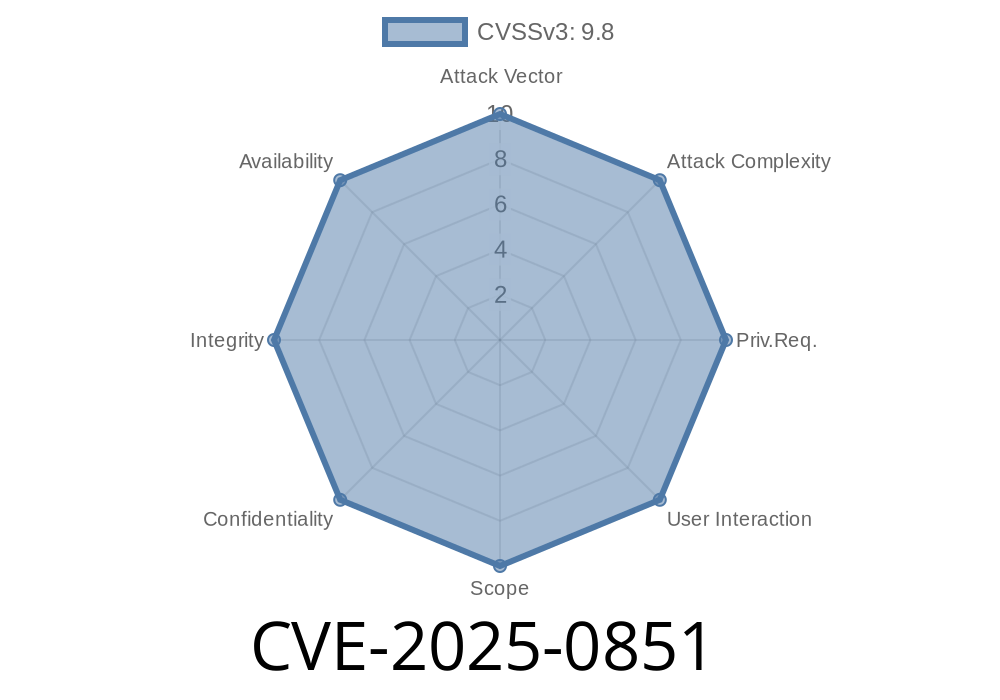CVE-2025-0851 is a security vulnerability discovered in the Deep Java Library (DJL), which allows a bad actor to perform path traversal attacks by exploiting the inherent issues in the ZipUtils.unzip and TarUtils.untar methods. This vulnerability exists across all platforms and poses a significant risk as it enables threat actors to write files to arbitrary locations on the target system, potentially leading to further attacks or data breaches.
In this post, we will thoroughly examine this vulnerability, share code snippets to demonstrate how it works, provide links to the original references, and discuss potential steps to mitigate such an attack vector.
Overview of Path Traversal Vulnerability
Path traversal vulnerabilities arise when user-supplied input is used to construct file paths without proper validation and sanitization. This allows an attacker to access and manipulate files outside of the intended directory, effectively traversing the file system hierarchy to arbitrary locations.
In the case of CVE-2025-0851, the vulnerability resides in the ZipUtils.unzip and TarUtils.untar functions in the Deep Java Library. By supplying a maliciously crafted archive containing files with malicious paths, an attacker can overwrite or create files, potentially leading to unauthorized access or further attacks.
Code Snippets Displaying Vulnerable Methods
Here are the code snippets from the Deep Java Library showing the vulnerable methods in the ZipUtils and TarUtils classes:
// Vulnerable method in ZipUtils.java
public static void unzip(File zipFile, String destDirectory) throws IOException {
try (ZipInputStream zipIn = new ZipInputStream(new FileInputStream(zipFile))) {
ZipEntry entry = zipIn.getNextEntry();
while (entry != null) {
String filePath = destDirectory + File.separator + entry.getName();
if (!entry.isDirectory()) {
extractFile(zipIn, filePath);
} else {
File dir = new File(filePath);
dir.mkdir();
}
zipIn.closeEntry();
entry = zipIn.getNextEntry();
}
}
}
// Vulnerable method in TarUtils.java
public static void untar(File tarfile, File destdir) throws IOException {
try (TarArchiveInputStream t = new TarArchiveInputStream(new GZIPInputStream(new FileInputStream(tarfile)))) {
TarArchiveEntry tarEntry = t.getNextTarEntry();
while (tarEntry != null) {
File destPath = new File(destdir, tarEntry.getName());
if (tarEntry.isDirectory()) {
destPath.mkdirs();
} else {
destPath.createNewFile();
try (FileOutputStream out = new FileOutputStream(destPath)) {
IOUtils.copy(t, out);
}
}
tarEntry = t.getNextTarEntry();
}
}
}
Both methods suffer from the same security flaw: the path of extracted files is created without proper sanitization, effectively allowing malicious entries in the archive to traverse the file system and write its content to unintended locations.
Exploiting the Vulnerability
To exploit this vulnerability, an attacker can create a malicious archive containing directory traversal payloads as file paths, such as:
../../../../../../../etc/passwd
../../../../var/www/html/malicious.php
When such an archive is processed using the vulnerable unzip or untar functions, the malicious files will be written outside the intended directory, effectively bypassing any boundary restrictions.
Steps for Mitigation
To safeguard against path traversal vulnerabilities in the Deep Java Library, developers should apply the following measures:
Update to the latest version of the library that contains patches for this vulnerability.
2. Sanitize input paths and validate them against a list of accepted paths or patterns before processing.
3. Employ a library or method that enforces path traversal protection when extracting files from an archive.
References and Further Reading
- CVE-2025-0851 Official Documentation
- Deep Java Library (DJL) GitHub Repository
- OWASP Path Traversal Cheat Sheet
- Path Traversal Prevention in Java
This post has provided an in-depth analysis of the CVE-2025-0851 vulnerability, presented how it can be exploited, and shared actionable steps to mitigate the risk. By following proper security practices, developers can significantly reduce the risk of attacks exploiting path traversal vulnerabilities in their applications.
Timeline
Published on: 01/29/2025 22:15:30 UTC
